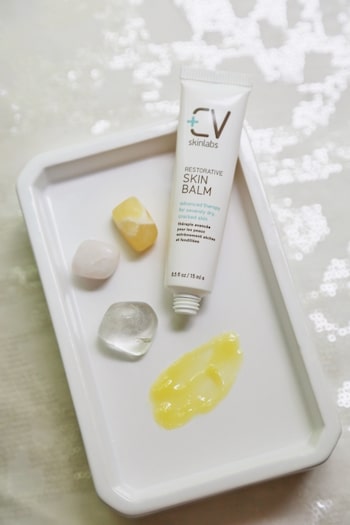
Our customers often ask us: What’s the difference between emollients and moisturizers?
These terms are often used in the skincare industry, and they may seem like the same thing. But there are several differences between them.
We explain what those are, and why you need both ingredients in your skincare products for your skin to be at its best.
What’s the Difference Between Emollients and Moisturizers: Generally Speaking
When you’re talking about skincare, these two terms are often used interchangeably. You may be speaking to a skincare representative, for example, who uses “emollient” to describe a moisturizer and vice-versa.
We like to think of “moisturizer” as being any product that helps hydrate, moisturize, soothe, soften, and repair skin. But a moisturizer must always treat dry skin. It must add moisture to the skin in some way to banish the dryness.
An “emollient,” on the other hand, is usually a specific type of ingredient in a moisturizing solution that helps soften, heal, and smooth the skin so that it feels softer to the touch.
 What’s the Difference Between Emollients and Moisturizers: Let’s Start with Emollients
What’s the Difference Between Emollients and Moisturizers: Let’s Start with Emollients
Look up the official meaning of “emollient,” and you’ll find something like this: “having the quality of softening or soothing the skin.”
Well that sounds a lot like a moisturizer, right?
Other definitions don’t help much. They all say that emollients are “moisturizing treatments” or “moisturizers” or “substances” that help soothe, soften, and hydrate the skin.
Okay, not seeing much difference here yet. So we have to dig a little deeper.
In the world of skincare, emollients are all about “softening” the skin and helping it to feel smooth. That means it’s not really about moisture or hydration level, but more about how the skin feels to the touch.
For this reason, emollients are often used to address problems with the skin barrier. Remember that outside layer of skin that protects it from invaders while keeping moisture in? That barrier can become damaged because of environmental assaults, skin disorders, aging, and more. When it does, the skin usually feels dry, rough, bumpy, or even hard. Emollients are there to address this issue.
An emollient can help tame the inflammation that’s often present in a damaged skin barrier while promoting healing and repair. The right emollient ingredients seal cracks in the skin barrier, filling gaps between skin cells with lipids (fats). This soothes the skin and helps it to hold onto the moisture that it has, which makes it smoother and softer to the touch.
Common ingredients that act as emollients include:
- Shea butter
- Cocoa butter
- Coconut oil
- Colloidal oatmeal
- Triglycerides (lipids)
- Squalene (a lipid naturally produced by the skin)
- Lanolin
- Oils like sunflower oil
These ingredients shine when it comes to treating dry and aging skin, as they help restore the skin’s natural barrier, reduce the appearance of fine lines and wrinkles, and soothe eczema and psoriasis flare-ups. They can also ease itching and make the skin feel more comfortable.
What’s the Difference Between Emollients and Moisturizers: What About Moisturizers?
Look up the official meaning of “moisturizer” and you find this: “a lotion or cream used to prevent dryness in the skin.”
This points to the main job of a moisturizer: to add moisture to the skin.
A moisturizer may help repair the skin as well, like an emollient, but it really shines at keeping the skin from drying out. The best moisturizers feed moisture into the skin, plumping it up and helping it look healthy.
We can break down moisturizers into two categories:
- Humectants: These attract water to the skin. They are like little magnets pulling water droplets from the air to your skin to keep it hydrated. They are usually on the lighter side and are absorbed quickly. Good examples include aloe, glycerin, hyaluronic acid, allantoin, honey, and seaweed.
- Occlusives: These form a barrier over the outside of the skin, defending against moisture loss and environmental damage. They also lock in any other ingredients in your moisturizer so that your skin receives all of their benefits. Some examples of occlusives include beeswax, olive and soybean oils, ceramides, butters, fatty acids, and lipids.
You may notice that some ingredients that qualify as occlusive moisturizers also qualify as emollients. That’s because they help fill in the cracks in the skin’s outer barrier, but when they do that, they help the skin hold onto moisture too. In essence, they are doing double-duty.
You can see why it’s easy to confuse these two terms!
 What’s the Difference Between Emollients and Moisturizers: Why You Need Both
What’s the Difference Between Emollients and Moisturizers: Why You Need Both
You don’t have to be an ingredient expert to find the best products for your skin.
Instead, just understand that you need products that have properties of both: they moisturize and contain emollients.
You want to feed moisturize into your skin, but you also want to repair that outer barrier so that the moisture isn’t lost.
At CV Skinlabs, we’ve done the work for you. All of our products have both moisturizers and emollients that go to work repairing, softening, smoothing, calming, and moisturizing your skin. This was one of the goals we had when creating them. We wanted a simple line of products that would take care of both of these important issues in aging, dry, and medically damaged skin.
No matter what may be causing your skin to suffer, it almost always involves a damaged skin barrier, inflammation, and dryness. You can address these basic issues with our CV Skinlabs products, and soon enjoy softer, smoother, younger-looking skin.
Do you understand the difference between emollients and moisturizers?

